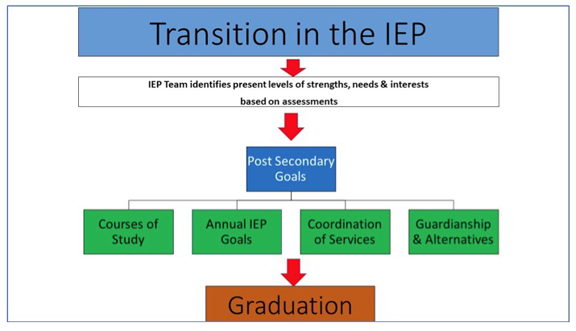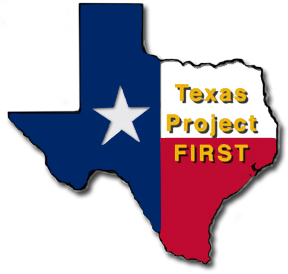en Español • Print • Share
Your child’s post-secondary goals are determined. Courses of study are mapped out for their high school years. Annual goals are created to support your child attaining the post-secondary goals. Now it is time to look at other activities that may need to occur to ensure a successful transition to adult life.
What do we mean by Coordinated Set of Activities?
The law (CFR §300.43) says transition services must be in the form of a coordinated set of activities for a student with a disability that:
- Is designed to be results-oriented (This means the services are intended to get results!)
- Is focused on improving the academic and functional achievement of the student. (Academics are an important part of the student’s school experience – not just functional or daily life skills.)
- Is designed to facilitate the student’s movement from school to post-school activities (the services will lead to the next steps after school.)
- Is based on the student’s individual needs.
- Takes into account the student’s strengths, preferences and interests.
- Includes instruction, related services, community experiences and the development of employment and post-school adult living objectives.
- When appropriate, can include acquisition of daily living skills and functional vocational evaluation. Daily living skills are not necessarily appropriate for every student. Students should experience academic opportunities all the way up to graduation.
The development of a “coordinated set of activities” has been a challenge to many. Part of the challenge has to do with understanding that this “statement” is not a sentence or pull down menu from a list of possible suggestions. It is not a “check box” on a form. This “statement” is a “broad accounting of:
- what will happen (activity),
- when it will occur (timeline),
- who is involved in each activity, and
- who is responsible (for providing and paying for the service)”.
The activities/strategies are not annual goals, short term objectives or benchmarks. In order to write these statements, families & educators need to think “big picture”. This type of planning is beyond just 12 months. It is about your child’s future life.
Coordination implies that all parties of the IEP/ARD committee take an active role in the transition planning process and its outcomes. This includes the student, the family, the school and any outside agencies or providers.
Areas of Coordination
So let’s look at the various areas that a coordinated set of activities may include.
Here are definitions from Helping Educators, Parents, and Other Stakeholders Understand Post School Outcomes, Course of Study, and Coordinated Set of Activities (2009) by Ed O’Leary & Wendy Collison.
Instruction - Activities/strategies listed in this area have to do with “instruction,” whether that is a formal or informal imparting of knowledge or skills. The activities/strategies can include, but are not limited to, such things as:
Broad curricular areas of needed coursework, educational experiences, skill training, etc. OR
Activities/strategies that are necessary to prepare for and take part in college, continuing education, further skill training, adult living, etc.
Related Services - Activities/strategies in this area should consider the current and projected related service needs of the student with determining if the related service needs will continue beyond school, helping to identify who or what agency might provide those services, helping to identify how the student and parent can access those services and then connecting the student and parent to whomever will provide those services before the student leaves the school system. See Related Services & Transition.
Community Experiences - Activities/strategies listed in this area emphasize activities/strategies that are generally provided outside the school building and that prepare the student for participation in community life. These activities should encourage the student to participate in the community, including government, social, recreational, leisure, shopping, banking, transportation, or other opportunities.
Employment - Activities/strategies listed in this area focus on development of work-related behaviors, job seeking and keeping skills, career exploration, skill training, apprenticeship training, and actual employment.
Post School Adult Living - Activities/strategies listed in this area emphasize activities/strategies that focus on adult living skills. These are generally those activities that are done occasionally such as registering to vote, filing taxes, obtaining a driver’s license, renting or buying a home, accessing medical services, obtaining and filing for insurance, planning for retirement, and accessing adult services such as Social Security.
Daily Living Skills - Daily living skills are those activities that adults do most every day. These can include such things as preparing meals, budgeting, maintaining a residence, paying bills, raising a family, caring for clothing, and/or personal grooming.
You do not have to have an activity under each of these areas, but you should consider each area when thinking about your child’s future. The areas addressed in the transition plan are based on your child’s needs, not what you want as a parent. These services may be documented in the Transition plan. The services can also change from year to year as the activities are completed.
Role of Outside Agencies
Linkages with other agencies should occur. The school may give you the contact information of services available in your community. Schools only need to get your permission to invite the outside agencies to meetings. Schools cannot require other agencies to attend IEP meetings. Take advantage of any transition or resource fairs offered. These are a great way to meet community providers and learn about adult programs, services and opportunities.
NOTE: Schools cannot sign your child up for programs or services provided by outside agencies. This is parent and/or adult child responsibility. Often there are waiting lists for services. It is important that you contact outside agencies well before graduation day. See Family Supports.
If your child is receiving services from an adult service agency, those representatives may be included in the planning process in order to ensure a “coordination of services”. For example, if your child is receiving in home supports from a Medicaid waiver and that agency is working on independent living skills with your child (i.e. using the washer/dryer; learning to cook), the adult service agency may work on those goals and the school might work on other goals to meet the post-secondary goals. The school cannot commit any other agency to provide services without the agency being present at the IEP meeting.
Remember, the transition plan is a “coordinated set of activities” which means that all parties, including parents, have a responsibility in making the transition plan successful. By working together with your school and adult service agencies, and with proper planning, you can better ensure that your adult child makes a smooth transition to adulthood.
Helping Educators, Parents, and Other Stakeholders Understand Post School Outcomes, Course of Study, and Coordinated Set of Activities (2009) by Ed O’Leary & Wendy Collison - This document explains IDEA transition requirements and includes sample transition activities and strategies that can be used by the IEP team to determine needed coordinated activities to address the student’s postsecondary goals.
Transition Services - Strategies & Activities (video) from Ed O’Leary of Cutting Edj Consulting resources
Visual Transition Plan (Pdf) and VTP student example (pdf)

